As Student Needs Grow, Education Groups Call for a $2.2 Billion State Aid Increase for 2019-20
Funding would bolster Foundation Aid effort, address critical needs and priorities.
Funding for education in New York has not kept pace with significant growth in student needs in recent years and the imperative to prepare students to succeed in a changing world. From 2006-07 to 2016-17, the total number of New York’s students receiving free or reduced price lunch increased by 15 percent, English language learners by 18 percent and students with disabilities by 14 percent. Districts are focused on improving school safety and addressing the growing need for student mental health services, while helping students achieve higher learning standards and prepare for the demands of college and careers. These priorities are all important. Yet while schools have seen increased funding in recent state budgets, Foundation Aid – designed to account for student needs – remains significantly underfunded.
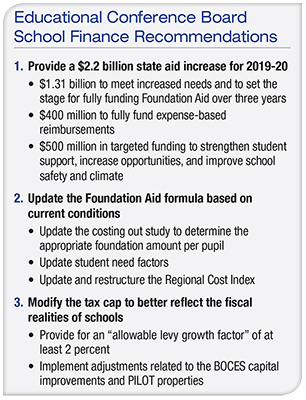 The Foundation Aid formula was intended to ensure each district has the resources to provide all students with a quality education. The state is approximately $4 billion behind what would be paid to schools if the formula were fully funded. The significant growth in student needs underscores the importance of a functioning aid formula that runs each year as intended. Schools also rely on expense-based aids to continue essential services such as pupil transportation and additional support is necessary for specific priority areas, from school safety to supporting struggling schools and English language learners.
The Foundation Aid formula was intended to ensure each district has the resources to provide all students with a quality education. The state is approximately $4 billion behind what would be paid to schools if the formula were fully funded. The significant growth in student needs underscores the importance of a functioning aid formula that runs each year as intended. Schools also rely on expense-based aids to continue essential services such as pupil transportation and additional support is necessary for specific priority areas, from school safety to supporting struggling schools and English language learners.
For these reasons, The New York State Educational Conference Board (ECB) – comprised of six leading educational organizations representing parents, classroom teachers, school related professionals, building administrators, superintendents and school boards – is recommending an overall $2.2 billion state aid increase for schools in the 2019-20 state budget. This amount includes: a $1.31 billion increase in Foundation Aid, approximately $400 million to fully fund expense-based reimbursements, and $500 million for five priority areas. More broadly, the groups call for an effort to review and update the Foundation Aid formula to better align it with present needs and costs. ECB members also continue to seek modifications to the tax cap that provide a greater degree of stability for schools.
Foundation Aid: A $1.31 billion increase recommended for 2019-20
The Foundation Aid formula implemented in 2007 was to be phased-in over a period of four years, but it was derailed by the Great Recession and its impact on New York’s economy and state budget. The formula was based on a study which aimed to estimate the per pupil cost of providing a sound basic education and calls for this foundation amount to be adjusted for pupil needs, regional cost variations and other factors to ensure all schools have the resources needed to help their students succeed. The formula generally drives the greatest amount of aid to districts with the greatest needs, but all districts stood to gain from the predictability and stability that it promised.
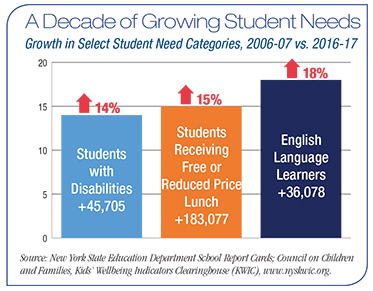 Given the approximately $4 billion in Foundation Aid that is outstanding and the growth in student needs, for 2019-20, ECB calls for $1.31 billion increase in Foundation Aid – a third of what is due to schools. This would help schools support students and continue programmatic investments. It would put the state on a trajectory to fully fund the Foundation Aid formula in three years. This should be a policy priority. There is no better way to provide schools with the ability to meet student needs, sustain quality programs, and engage in responsible fiscal and educational planning.
Given the approximately $4 billion in Foundation Aid that is outstanding and the growth in student needs, for 2019-20, ECB calls for $1.31 billion increase in Foundation Aid – a third of what is due to schools. This would help schools support students and continue programmatic investments. It would put the state on a trajectory to fully fund the Foundation Aid formula in three years. This should be a policy priority. There is no better way to provide schools with the ability to meet student needs, sustain quality programs, and engage in responsible fiscal and educational planning.
Expense-based reimbursements ($400 million)
As part of its 2019-20 state aid recommendations, ECB calls for full-funding for expense-based reimbursements, estimated at $400 million by the State Education Department. These reimbursements provide for the continuation of essential programs and services, from student transportation and special education to investing in technology and meeting capital improvement commitments. Fully funding these aids is a matter of fiscal stability and providing necessary student services.
Fund improvement initiatives and needs ($500 million)
As part of the overall recommended state aid increase, ECB suggests $500 million in targeted funding for five priority areas to strengthen student support and expand opportunities across New York.
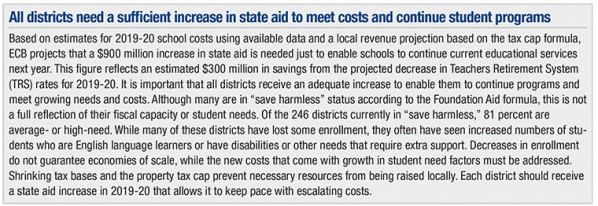
(1) Support district efforts to strengthen school safety and address mental health issues and school climate:
As communities across the country continue to be devastated by violence in schools, districts are continuing to explore and implement new measures to keep students safe, including equipment, infrastructure and staffing. Districts are also working to improve overall school climate and address a growth in student mental health needs. In recent surveys of New York’s school superintendents, student mental health support has been identified as an area of need, with 56 percent of those who responded to an August 2018 survey selecting increasing “mental health, social work and related services” as a top funding priority. A new funding stream that will help all districts improve safety and school climate and provide student mental health services is necessary.
(2) Sufficient support for schools designated as Struggling and Persistently Struggling:
As the state again revamps the process of designating these schools with the implementation of the Every Student Succeeds Act (ESSA), ECB continues to emphasize the need for additional, sustained financial support. This would allow designated schools to not just make improvements, but to sustain them over time. These school systems are among those with the least available local resources and serve many students in poverty. Increasing student achievement requires a long-term commitment of adequate funding.
(3) Professional development for teachers and administrators:
New York State and its schools have been leaders in elevating learning standards, focusing on the knowledge and skills students need to be successful in a dynamic, global economy. Funding for professional development for teachers and administrators is necessary to make sure these standards are successfully implemented in classrooms across the state.
(4) Helping English language learners achieve:
There are more than 237,000 students in New York’s schools for whom English is not their first language. These students attend schools in all parts of the state. Once fully phased-in, the Foundation Aid formula will support districts in serving English language learners, but targeted funding should be provided now to help schools meet emerging needs and give these students the services they deserve.
(5) Expanding College and career pathways:
As the world has changed, educational leaders have been right to focus on new pathways to graduation, college and careers – including preparing students for positions in sectors and industries that face a shortage of skilled workers and are important to our economy. These pathways include career and technical education programs. However, the caps on aid for BOCES salaries and Special Services Aid in Big 5 districts, which have not been increased for many years, preclude a sufficient level of investment to modernize these programs and make them available to more students. These caps must be increased and the formulas must be expanded to cover all high school students.
Update the Foundation Aid Formula Components
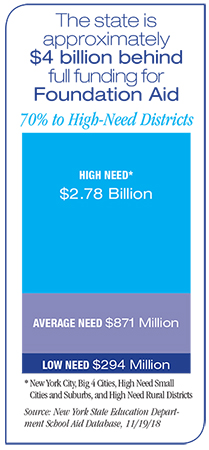 The 2007 Foundation Aid formula was a significant public policy achievement. ECB members believe that the premise of the formula – ensuring that each district has the resources to provide students with an education that prepares them for the future – should remain the underpinning of School Aid policy in the state. However, much has changed in the more than 10 years that have passed since the formula was adopted. School district demographics have evolved. Learning standards have increased and new regulations have been enacted. Districts must also now comply with a tax cap that hampers their ability to fund programs and services locally.
The 2007 Foundation Aid formula was a significant public policy achievement. ECB members believe that the premise of the formula – ensuring that each district has the resources to provide students with an education that prepares them for the future – should remain the underpinning of School Aid policy in the state. However, much has changed in the more than 10 years that have passed since the formula was adopted. School district demographics have evolved. Learning standards have increased and new regulations have been enacted. Districts must also now comply with a tax cap that hampers their ability to fund programs and services locally.
ECB members call for a commitment by the state to take longer-term actions related to the Foundation Aid formula, as outlined below.
(1) Conduct a new cost study to determine the per pupil foundation amount.
The original foundation amount per pupil was based on a study of the cost of education in districts deemed successful. This amount would then be adjusted for district-specific factors such as student needs and regional costs. That study is now more than 15 years old. ECB recommends a new study to establish a new foundation amount per pupil, given the changes in learning standards and other requirements.
Review and update how student needs are accounted for in the formula.
Since the Foundation Aid formula was enacted, percentages of students in poverty have risen in many districts, as have the number of English language learners. The initial weightings for these factors, as well as students with disabilities, should be reviewed and updated – particularly as we learn more about the impact of concentrated poverty on the learning environment and the supports needed to properly address a variety of needs.
Restructure the Regional Cost Index
This index adjusts Foundation Aid to reflect variations in the cost of delivering services in different parts of the state. While the state’s economy has evolved, the index values have not been updated since 2007. Further, the index groups the state’s districts into nine regions, which contributes to dramatic differences among nearby districts that could be addressed with the use of more regions.
Addressing the above recommendations will require careful study and the involvement of many stakeholders. ECB members are not calling for these changes to take place in time for the 2019-20 state budget process. Rather, we suggest that the process begin now so that results can be evaluated, debated and refined in time to be factored into the 2020-21 state budget. Updating and funding the formula is necessary to preserve the promise of Foundation Aid and enhance programmatic and fiscal stability for schools, communities and children.
A tax cap that better reflects the fiscal realities of schools.
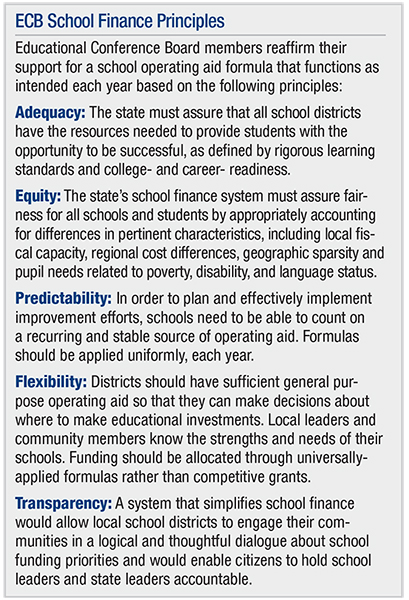 ECB renews its call to modify the tax cap formula so that it provides school districts and taxpayers with more stability. The use of the Consumer Price Index (CPI) in the tax cap is problematic, as the general cost of consumer goods is not an appropriate indicator for the cost structure of providing educational services. This is further exacerbated by capping the tax levy growth factor at the lesser of the change in CPI or 2 percent, which resulted in four consecutive years (2014-15 to 2017-18) that schools had to contend with a growth factor below 2 percent. Yet, in years when CPI growth is projected above 2 percent, the growth factor is simply capped at 2 percent. This will be the case in the coming year, given a current projection for the change in CPI of 2.5 percent. This approach diminishes the ability of districts to keep pace with rising costs. The tax cap formula should be amended to remove the variability of CPI and provide schools with an allowable levy growth factor of at least 2 percent each year.
ECB renews its call to modify the tax cap formula so that it provides school districts and taxpayers with more stability. The use of the Consumer Price Index (CPI) in the tax cap is problematic, as the general cost of consumer goods is not an appropriate indicator for the cost structure of providing educational services. This is further exacerbated by capping the tax levy growth factor at the lesser of the change in CPI or 2 percent, which resulted in four consecutive years (2014-15 to 2017-18) that schools had to contend with a growth factor below 2 percent. Yet, in years when CPI growth is projected above 2 percent, the growth factor is simply capped at 2 percent. This will be the case in the coming year, given a current projection for the change in CPI of 2.5 percent. This approach diminishes the ability of districts to keep pace with rising costs. The tax cap formula should be amended to remove the variability of CPI and provide schools with an allowable levy growth factor of at least 2 percent each year.
ECB also calls on lawmakers to approve two adjustments to the tax cap that have been discussed since the inception of the law: excluding local capital expenses for BOCES instructional improvements and including properties covered by payments in lieu-of-taxes (PILOTs) in the formula’s tax base growth factor. These changes would result in a formula that is consistent in its treatment of capital improvements in public education and new construction in communities. This should be coupled with changes in the carryover allowance to give districts an incentive to hold tax increases below 2 percent in years when they can and apply the savings when needed in tougher years.
Conclusion
Whether it is poverty, disability, mental health services or learning English, the needs of today’s students are real – and they are growing. They must be addressed if we are going to provide all students with an educational experience that allows them to be successful in school and go on to pursue college and careers. Absent the necessary resources, school leaders will increasingly have diminished ability to meet demonstrated needs while also continuing proven programs. High learning standards for all, school safety, supporting struggling schools, and new pathways to higher education and the workforce are essential priorities. Yet, achieving them requires the right investment, sustained over time. Enacting the recommendations in this paper would help bridge the gap between current levels of funding and the programs and services that New York’s students need to be prepared for the future.
